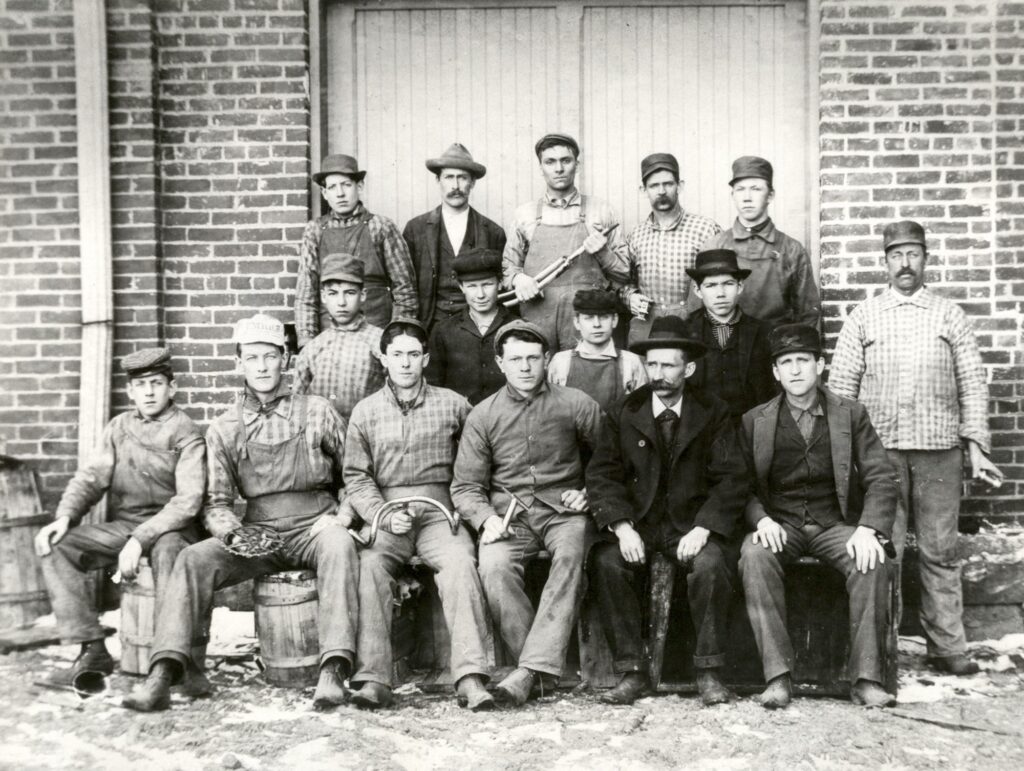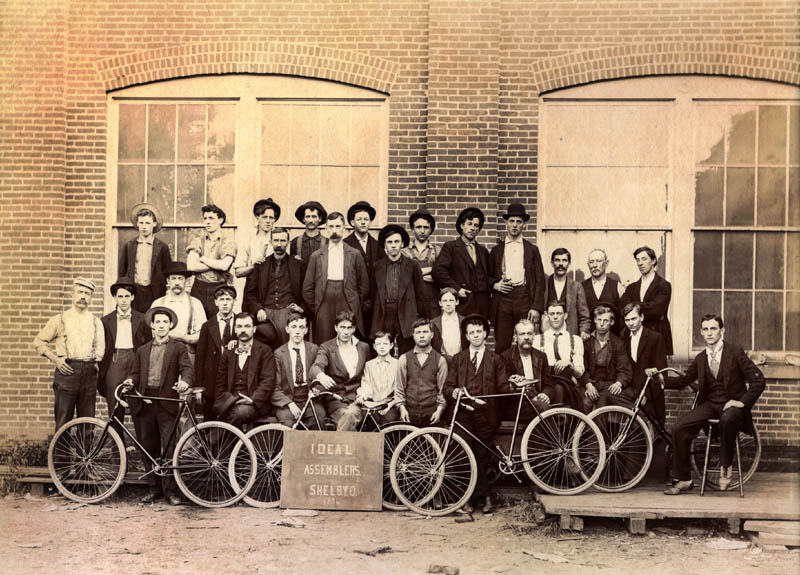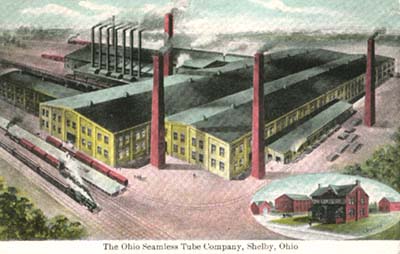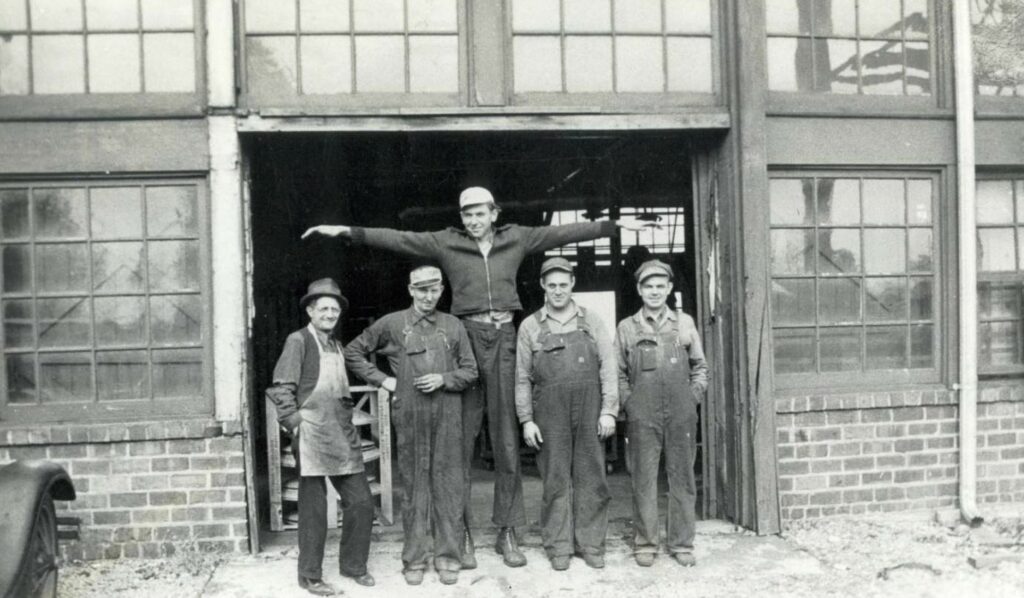Tour at Your Own Pace – By Car or Bicycle
Explore the Shelby Steel & Wheel Tour by car or bike! Learn more about each stop on our website, including the fascinating stories behind these historic factories and homes. Please note: All homes are privately owned. Enjoy from the street and do not trespass—respect for property is appreciated.

Shelby Bicycle Museum at the Justice Center
31 Mack Ave.
The Justice Center is the site of the Shelby Cycle Frame Builders from 1921-1924 and the Shelby Cycle Company from 1925-1953.
The Shelby Cycle Frame Builders occupied the former Shelby Lamp Company factory from 1921-1924. As the company floundered, Joe Seltzer infused the company with additional capital and the Shelby Cycle Company began to make complete bikes.
At it’s height in 1937, more than 200,000 bicycles were made by 400 employees working day and night.


Shelby Cycle Manufacturing Company
15 East Smiley Avenue
Two bicycle companies were established at this location. The first Shelby Cycle Manufacturing Company was formed in 1891by board members of the Shelby Steel Tube Company and only made bicycle parts. The bicycle factory closed in 1892 and the building was used by the tube factory. Gormully & Jeffery of Chicago purchased the building and began producing Ideal Bicycles from 1895 – 1901.
Fish/ Gump/Sheets Home
23 Marvin Avenue
Most commonly Known as the Sheets Home as Henry and Lida (Wolf) Sheets lived at 23 Marvin from 1911 to 1964. Henry Sheets was vice president of the Shelby Salesbook and editor and publisher of the Shelby Republican newspaper. Lida planted more than 400 rose bushes in the 50 years they lived in the home.
The 28 -room three-story home was built in 1879 by Cortez F. Fish, a Vermonter who owned a flour mill in Shelby. The home had a music room on the southwest corner of the first floor, large enough for small concerts. A reservoir on the third floor could hold 30,000 gallons of rainwater collected from the roof for household use. The house also contains a full basement.
Fish’s wife Helen sold the home to Sarah (Black) Gillenen in 1891 for $5,200. Sarah owned a shoe store in the Union Block on the northeast corner of Main and Gamble streets.
Elizabeth B. Gump, wife of Albert W. Gump, bought the home in 1895 from Sarah. Albert and Elizabeth moved from Dayton, where Albert became manager and treasurer of the Shelby Cycle Manufacturing Company (Ideal Bikes). Elizabeth sold the home to the Sheets family in 1911.

John Seltzer Home
46 Marvin Avenue
John Strock Seltzer led the Shelby Cycle Co. from 1929 to 1945, its most successful era. During the Great Depression, the company thrived, producing the iconic Shelby bicycle and providing jobs for hundreds.
Benjamin J. Williams Home
54 Marvin Avenue
Benjamin J. Williams was a cashier, then president of the First National Bank in Shelby. He was a key player in bringing the first seamless tube factory to Shelby, becoming a stockholder and treasurer of the Shelby Steel Tube Company in 1890. He was also director of the Shelby Water Company and stockholder in nearly every factory in town. B. J. and Ida Williams built the three-story Victorian home with 14 rooms and 6 baths circa 1897.
Son Whiting Williams lived in the home as a child. Whiting was a author of books and article on labor relations in the early 20th Century, frequently going undercover to work as a laborer.
Shelby’s longest running mayor Charles (C.E.) Morris also lived in the home. He served through some of the most important moments in Shelby history, as Shelby became a city and adopted a charter government.
David Cockley Home
170 West Main Street
Named Shelby’s father of Industrialism, David Cockley came to prominence during the Civil War, first serving as an enlisted man in the 15th OVI, then as a captain in the 10th Ohio Cavalry, earning the Medal of Honor for his leadership and bravery in battle. After the war, he moved to Shelby with his wife Eunice and established a hardware store, and operated a flour mill. Cockley was instrumental in forming the Shelby Steel Tube Company and was its first president, serving for seven years. The self-made millionaire also financed an umbrella rib factory and automobile factory. He began building the four-story 22-room home north of the Tube works in 1897 with a tack room for his horses, a bowling alley and billiards room. He died of a heart attack in the foyer of his home December 26, 1901.
Joe Seltzer Home
168 West Main Street
Joseph Seltzer arrived in Shelby in 1870 with just fifteen cents and became one of its most influential citizens. A savvy businessman, he co-owned a hardware store, helped found the Shelby Steel Tube Co., and brought new industries to town. His investment saved the Shelby Cycle Frame Company, which became Shelby Cycle Co. in 1925. As president, Seltzer led it to success, preserving jobs and boosting Shelby’s industrial growth. The home, built in 1885, has been a funeral home since 1931.

ArcelorMittal
132 West Main Street
Through fires, wars, depressions, and mergers, the nation’s first cold-drawn steel tube company still produces seamless tubing in Shelby, Ohio, 135 years later as ArcelorMittal. In the 1880’s seamless tubing was imported from Europe. Bicycle manufacturers in Toledo and Cleveland brought the technology to America. In 1890, the Lozier-Yost Seamless Tube Company/Shelby Steel Tube Company, was formed in Shelby. The town, just a crossroads with a flour mill, nevertheless, was viewed as a prime location with two rail lines and supportive businessmen who raised funding to bring the factory to town.

Chicago Handle Bar Company
Easterling Park, South Street
In 1904, Frederick L. Watters, president of the Chicago Handle Bar Company, sought to relocate after labor issues and losing their factory to fire. Shelby Tube superintendent A.C. Morse encouraged a visit to Shelby, Ohio—already the company’s tubing supplier. With skilled workers from the recently closed Ideal plant and strong local support, Shelby businessmen raised $10,000 to build a new factory. The Shelby Land Improvement Company constructed a brick plant on South Street, completed by August. By September, operations resumed with 100 workers producing handlebars, seat posts, and furniture, shipping globally. The business was dissolved in 1927. moved to Torrington Company in Connecticut purchased the machinery. After numerous attempts to sell the Shelby factory building, it was demolished in 1937.
Leon A. Smith Home
43 Grand Boulevard
The Shelby Cycle Co.’s success is largely due to superintendent Leon A. Smith. In 1924, he and 18 others kept the struggling factory open, leading to profits and full bicycle production by 1925. Over 30 years, Smith also served as secretary-treasurer and vice president, inventing improvements in bicycles and manufacturing.
